#16th century dress
Explore tagged Tumblr posts
Text

submitted by @shilohta 💙🩶
#there are some comments i could make here#but i shan't say.........#i'll leave that up to y'all 💕#historical fashion poll submission#very historical historical fashion polls#historical fashion polls#fashion poll#historical dress#historical fashion#dress history#fashion history#fashion plate#16th century#16th century fashion#16th century dress#1500s#1510s#trousers
210 notes
·
View notes
Text
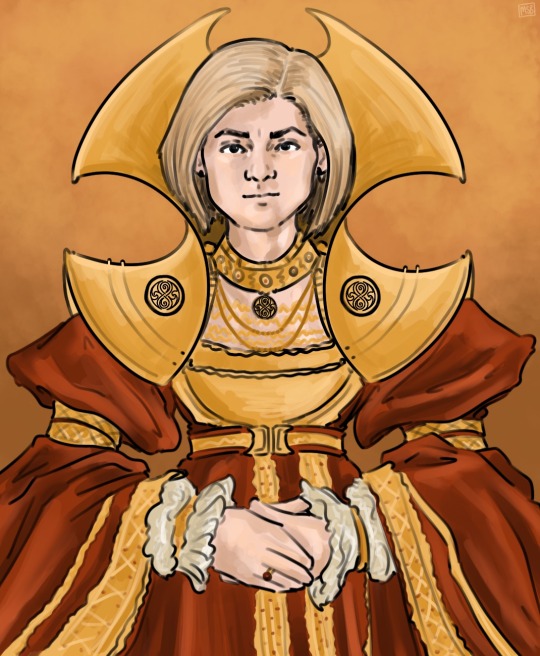
a time lady
#13 has never looked this serene in her life but hey#so I was watching arc of infinity right#and realised that High Chancellor Thalia’s dress so looks like a 16th century burgundinian/‘the Holbein Anne of Cleves portrait’ dress#and then this happened#possibly my nerdiest art ever lol#I almost drew lala in this fit but I haven’t drawn 13 in ages sooooo have#thirteenth doctor#13th doctor#Jodie Whittaker#Doctor who#Gallifrey#time lord#time lady#my art#fanart#minsart#they should have put Jodie in time lord garb tbh she would so pull it off
478 notes
·
View notes
Text










My Lady Jane + Costumes
Jane Grey's white & golden wedding dress in Season 01, Episode 01 & 02.
#My Lady Jane#Jane Grey#costumes#costume drama#costumesource#period drama#perioddramaedit#1500s#16th century#white#gold#wedding dress#England#Britain#Europe
213 notes
·
View notes
Text

The bridal jewelry. Venetian women in the 16th century, 1872
By Cesare Dell'acqua
#art#painting#fine art#classical art#italian art#italian artist#italian painter#oil painting#19th century art#beauty#italian#venetian#southern europe#italy#16th century#1700s#european art#dress#fashion#historical fashion#european culture#jewelry#venice
84 notes
·
View notes
Text
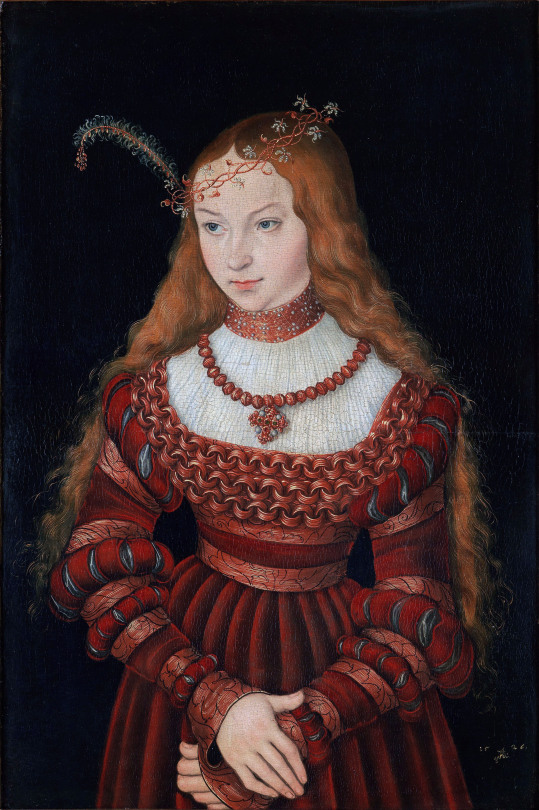
Sibylle of Cleves by Lucas Cranach the Elder, 1526.
#classic art#painting#lucas cranach the elder#german artist#16th century#portrait#female portrait#black background#fashion#red dress
631 notes
·
View notes
Text


୨୧¦ Edwardian novelty silver Vesta Case ഒ·°
︶֪︶︶֪︶ ིྀ ︶︶֪︶ ୨ৎ︶֪︶︶֪︶ ིྀ ︶︶֪︶
#🚬#lighter#ciggarette#vintage#sharp#dagger#sword#19th century#🎀。゚・。゚ᐠ( ᐢ ᵕ ᐢ )ᐟ。゚・。゚🎀#light academia#dark academia#aesthetic#moodboard#16th century#17th century#vintage dress#art#artwork#vintage art#ઇ꒰ ゚◞ ◟゚ ꒱ଓ
85 notes
·
View notes
Photo

Portrait of a lady as Ceres by an artist of the French School of Fontainebleau, c. 1550–1599
#School of Fontainebleau#france#16th c. france#mid 16th century#late 16th century#allegory#mdp16th c.#dress up#16th century
41 notes
·
View notes
Text

Portrait of Marguerite d'Angoulême, Queen of Navarre
Artist: Jean Clouet (Netherlandish, c. 1485-1540/1)
Date: c. 1527
Medium: oil painting on oak
Collection: National Museums Liverpool, Liverpool, United Kingdom
Description
Marguerite (1492-1549) was the sister of King Francis I of France. The painting may be by his court artist Jean Clouet, who portrayed the King against a similar background (Louvre, Paris).
The cupid brooch on her hat and ring suggest the portrait may celebrate her marriage to the King of Navarre in 1527. The meaning of the bird, a rose-ringed parakeet, is uncertain. It could symbolize marital chastity, eloquence or have a family significance: a similar bird is found in another portrait of her brother by Clouet. The golden knots on her headdress resemble daisies - marguerites in French.
#portrait#half lenght#painting#artwork#marguerite d'angouleme#queen of navarre#spanish history#oil painting#fine art#woman#costume#cupid brooch#hat#rose-ringed parakeet#ruffles#pendant#blue dress#netherlandish culture#netherlandish art#marguerite of navarre#french princess#house of angouleme#spanish royalty#jean clouet#netherlandish painter#16th century painting#european art#national museums liverpool
24 notes
·
View notes
Text

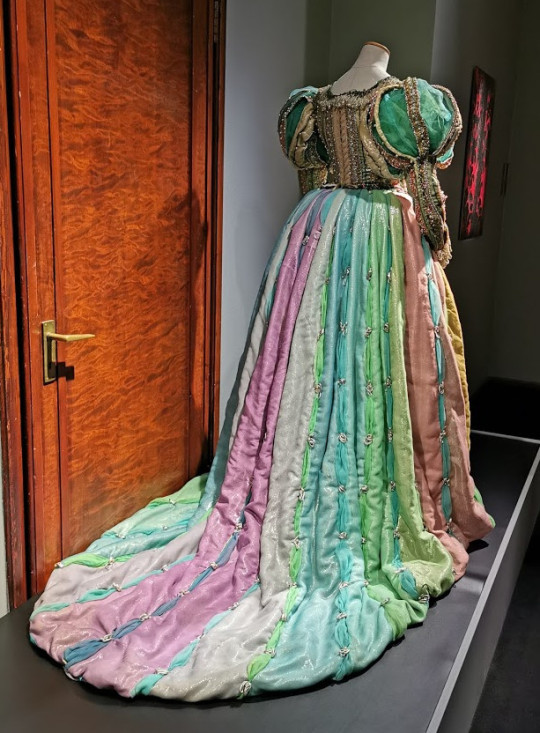
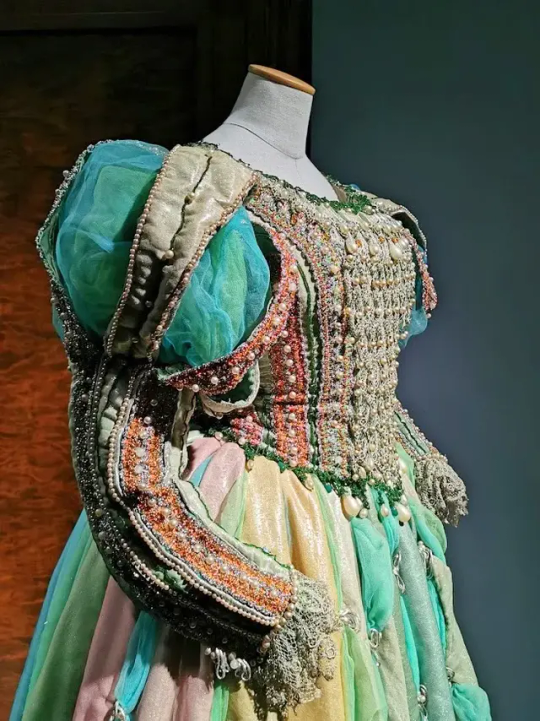
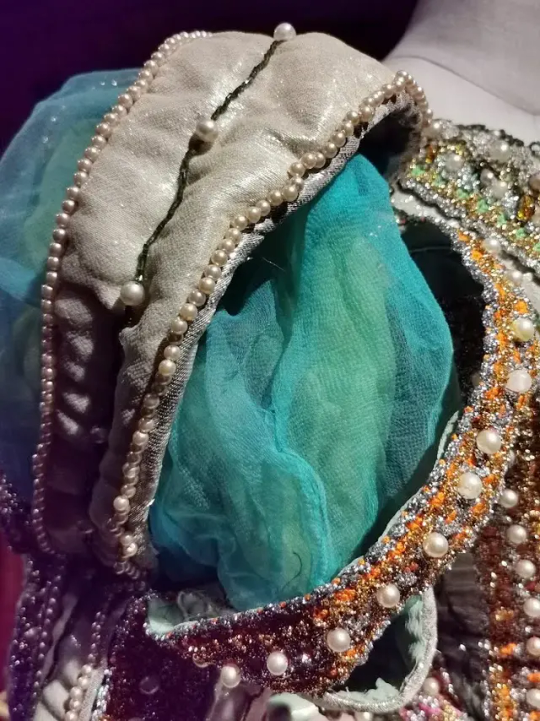
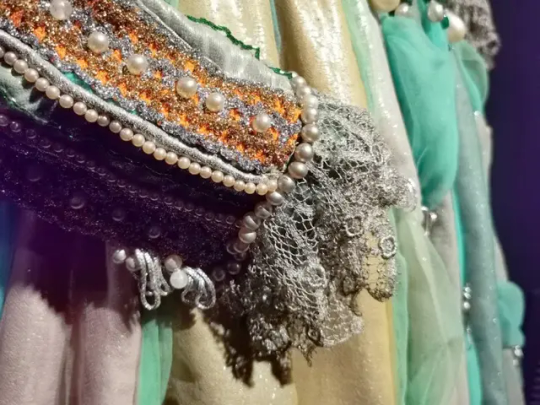
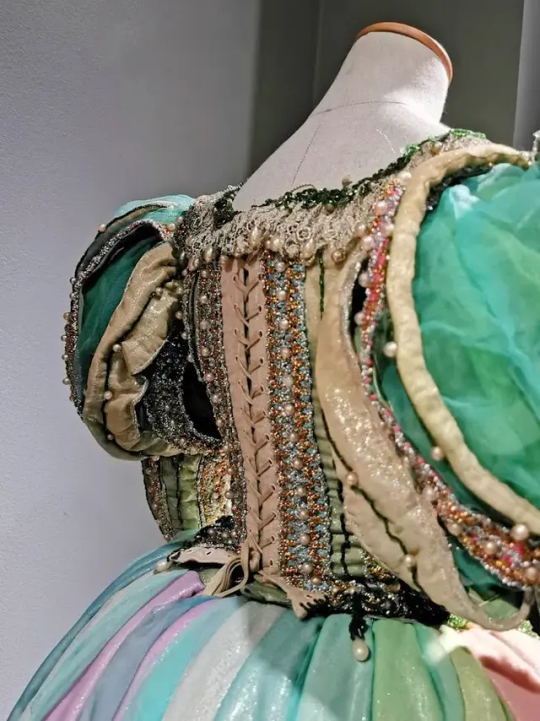
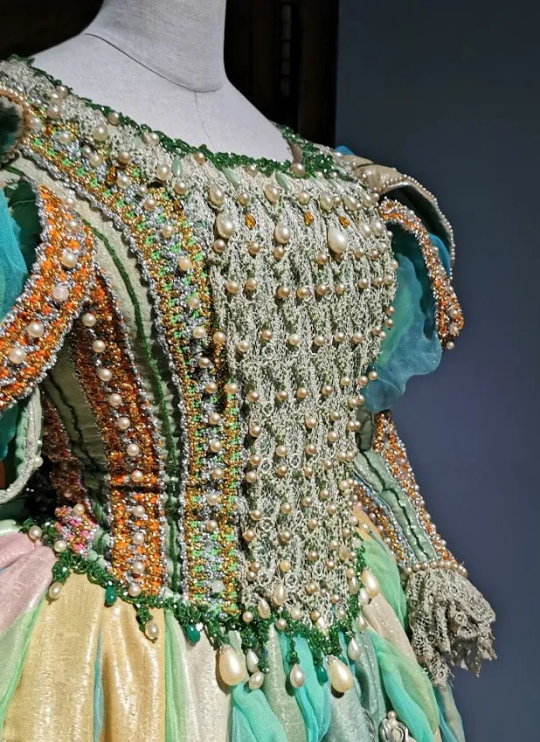
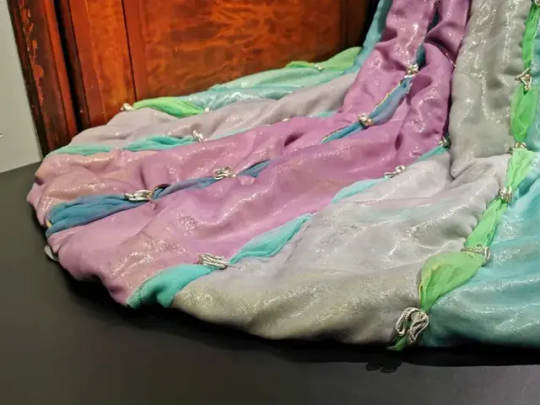
One Dress a Day Challenge
Anything Goes December
The Taming of the Shrew / Costume for Elizabeth Taylor as Katharina Minola(?)
I'm tremendously curious about this gown. It appeared in an exhibit titled "Glamour: Famous Gowns of the Silver Screen" in Finland in 2020. FrockFlicks did a a fine writeup of the exhibit in which they dubbed this the "unicorn dress." But it doesn't appear in the actual film!
It looks like an alternate version of the wedding dress, possibly intended to make Katharina match more closely with Petruchio's outlandish multicolored costume--but that's just a guess. If it wasn't used, why was it constructed? And was it designed by Irene Sharaff, who did Elizabeth Taylor's other gowns for this film, or by Danilo Donati, who designed everyone else's costumes?
#the taming of the shrew#anything goes december#elizabeth taylor#one dress a day challenge#one dress a week challenge#16th century costumes#movie costumes#period film#renaissance style#renaissance costumes#shakespeare adaptations#shakespear costumes#1967 movies#1967 films#multicolored august#multicoloured august#not appearing in this film
135 notes
·
View notes
Text
Irish dress history sources online:
A list of sources for Irish dress history research that free to access on the internet:
Primary and period sources:
Text Sources:
Corpus of Electronic Texts (CELT): a database of historical texts from or about Ireland. Most have both their original text and, where applicable, an English translation. Authors include: Francisco de Cuellar, Luke Gernon, John Dymmok, Thomas Gainsford, Fynes Moryson, Edmund Spenser, Laurent Vital, Tadhg Dall Ó hUiginn
Images:
The Edwin Rae Collection: A collection of photographs of Irish carvings dating 1300-1600 taken by art historian Edwin Rae in the mid-20th c. Includes tomb effigies and other figural art.
National Library of Ireland: Has a nice collection of 18th-20th c. Irish art and photographs. Search their catalog or browse their flickr.
Irish Script on Screen: A collection of scans of medieval Irish manuscripts, including The Book of Ballymote.
The Book of Kells: Scans of the whole thing.
The Image of Irelande, with a Discoverie of Woodkarne by John Derricke published 1581. A piece of anti-Irish propaganda that should be used with caution. Illustrations. Complete text.
Secondary sources:
Irish History from Contemporary Sources (1509-1610) by Constantia Maxwell published 1923. Contains a nice collection of primary source quotes, but it sometimes modernizes the 16th c. English in ways that are detrimental to the accuracy, like changing 'cote' to 'coat'. The original text for many of them can be found on CELT, archive.org, or google books.
An Historical Essay on the Dress of the Ancient and Modern Irish By Joseph Cooper Walker published 1788. Makes admirable use of primary sources, but because of Walker's assumption that Irish dress didn't change for the entirety of the Middle Ages, it is significantly flawed in a lot of its conclusions. Mostly only useful now for historiography. I discussed the images in this book here.
Chapter 18: Dress and Personal Adornment from A Smaller Social History of Ancient Ireland by P. W. Joyce published 1906. Suffers from similar problems to An Historical Essay on the Dress of the Ancient and Modern Irish.
Consumption and Material Culture in Sixteenth-Century Ireland Susan Flavin's 2011 doctoral thesis. A valuable source on the kinds of materials that were available in 16th c Ireland.
A Descriptive Catalogue of the Antiquities in the Museum of the Royal Irish Academy Volumes 1 and 2 by William Wilde, published 1863. Obviously outdated, and some of Wilde's conclusions are wrong, because archaeologists didn't know how to date things in the 19th century, but his descriptions of the individual artifacts are worthwhile. Frustratingly, this is still the best catalog available to the public for the National Museum of Ireland Archaeology. Idk why the NMI doesn't have an online catalog, a lot museums do nowadays.
Volume I: Articles of stone, earthen, vegetable and animal materials; and of copper and bronze
Volume 2: A Descriptive Catalogue of the Antiquities of Gold in the Museum of the Royal Irish Academy
A Horsehair Woven Band from County Antrim, Ireland: Clues to the Past from a Later Bronze Age Masterwork by Elizabeth Wincott Heckett 1998
Jewellery, art and symbolism in Medieval Irish society by Mary Deevy in Art and Symbolism in Medieval Europe- Papers of the 'Medieval Europe Brugge 1997' Conference (page 77 of PDF)
Looking the part: dress and civic status and ethnicity in early-modern Ireland by Brid McGrath 2018
Irish Mantles, English Nationalism: Apparel and National Identity in Early Modern English and Irish Texts by John R Ziegler 2013
Dress and ornament in early medieval Ireland - exploring the evidence by Maureen Doyle 2014
Dress and accessories in the early Irish tale, ‘The Wooing of Becfhola’ by Niamh Whitfield 2006
A tenth century cloth from Bogstown Co. Meath by Elizabeth Wincott Heckett 2004
Tertiary Sources:
Medieval Ireland: An Encyclopedia edited by Sean Duffy published 2005
Re-Examining the Evidence: A Study of Medieval Irish Women's Dress from 750 to 900 CE by Alexandra McConnell
#resources#dress history#irish dress#irish history#early medieval#bronze age#textile history#late medieval#16th century#historical dress
112 notes
·
View notes
Text
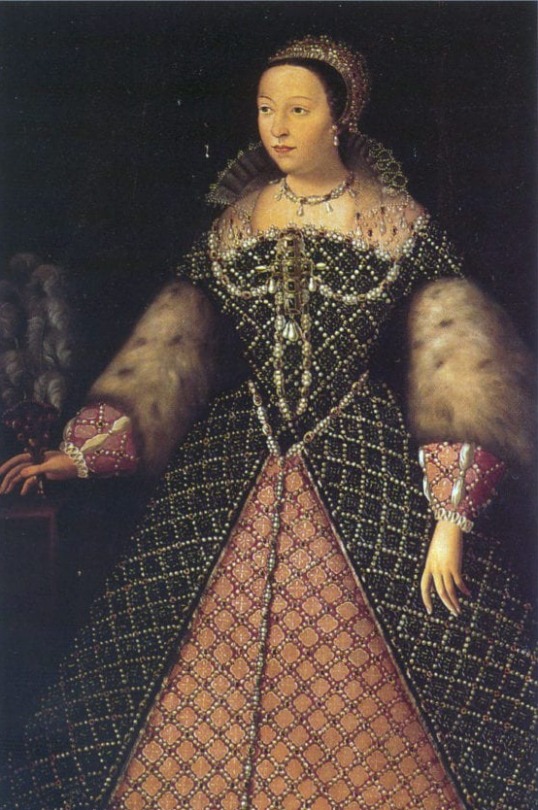
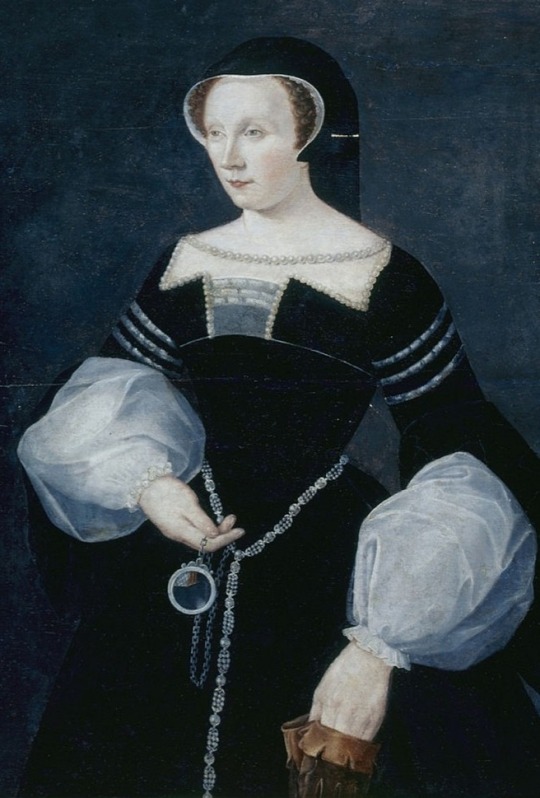
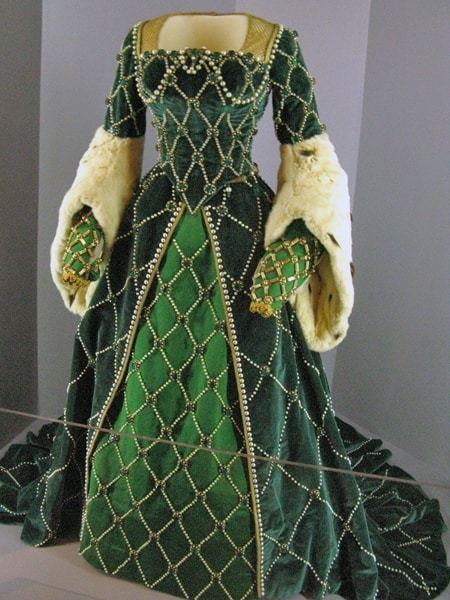
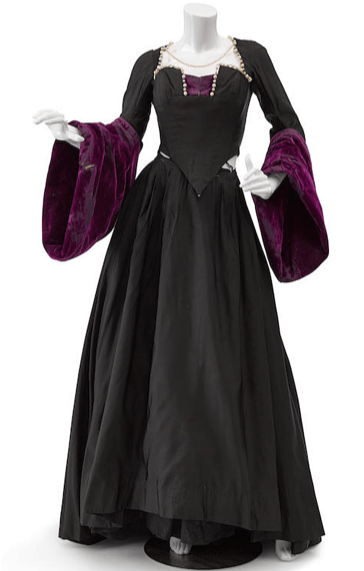
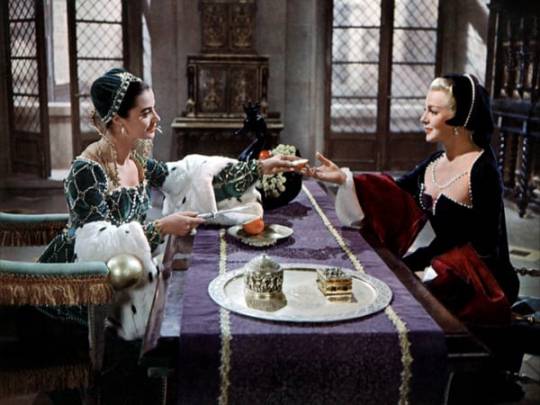
The gowns designed by Walter Plunkett for Diane (1956), with Marisa Pavan as Catherine de Medici and Lana Turner as Diane de Poitiers, alongside the historical portraits he based them on.
#I knew about the green dress but didn’t realized the other had historical basis as well#I thought the kind of boob-framing bodice was silly#like that one gown from Outlander#obv he has more boobage involved as opposed to the flat-fronted 16th century silhouette#but that is because Lana Turner has boobage the people want to see#fashion history#costume reproductions#16th century
71 notes
·
View notes
Text

submitted by @shilohta 🤍🩵💚
#historical fashion poll submission#very historical historical fashion polls#historical fashion polls#fashion poll#historical dress#historical fashion#dress history#fashion history#fashion plate#16th century#16th century fashion#16th century dress#1530s#1540s#1550s#1560s#1570s#1580s#1590s#skirt
185 notes
·
View notes
Text



Survived
#Catherine Parr#House of Tudor#Henry VIII#English history#16th century#Henry's last Queen#royal portraits#monarchy#survived#Tudor England#jewellery#courtly dress#UK
23 notes
·
View notes
Text






Reign + Costumes
Mary Stuart's white wedding dress in Season 01, Episode 13.
#Reign#Mary Stuart#Mary Queen of Scots#costumes#costume drama#costumesource#period drama#perioddramaedit#1500s#16th century#white#wedding dress#France#Europe
35 notes
·
View notes
Text

Oil painting, ca. 1537, Italy.
Portraying Eleanor Gonzaga in a black dress.
Painted by Titian.
Uffizi Gallery.
#uffizi gallery#painting#1537#Italy#1530s#1530s Italy#1530s painting#dress#1530s dress#black#16th century#Titian#Eleanor Gonzaga
118 notes
·
View notes
Text

Isabella of Portugal by Titian, 1548.
#classic art#painting#titian#italian artist#16th century#portrait#female portrait#indoor portrait#empress#holy roman empress#queen#queen of spain#habsburg#fashion#brown dress#pearls#window view
102 notes
·
View notes